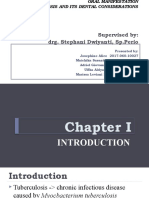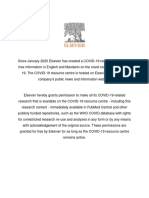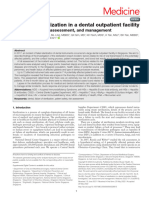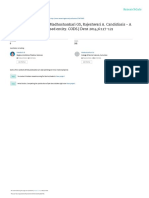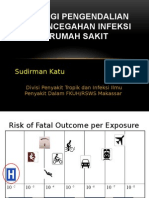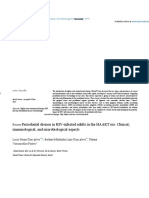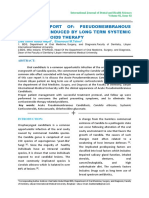Professional Documents
Culture Documents
Dental Considerations in Patient's With Infectious Disease
0 ratings0% found this document useful (0 votes)
56 views5 pagesThe rapid transportation methods are
abundant in this century
Original Title
Dental Considerations in Patient’s With Infectious Disease
Copyright
© © All Rights Reserved
Available Formats
PDF, TXT or read online from Scribd
Share this document
Did you find this document useful?
Is this content inappropriate?
Report this DocumentThe rapid transportation methods are
abundant in this century
Copyright:
© All Rights Reserved
Available Formats
Download as PDF, TXT or read online from Scribd
0 ratings0% found this document useful (0 votes)
56 views5 pagesDental Considerations in Patient's With Infectious Disease
The rapid transportation methods are
abundant in this century
Copyright:
© All Rights Reserved
Available Formats
Download as PDF, TXT or read online from Scribd
You are on page 1of 5
Volume 7, Issue 2, February – 2022 International Journal of Innovative Science and Research Technology
ISSN No:-2456-2165
Dental Considerations in Patient’s
with Infectious Disease
Dr. Kumari M Dr. Sai Charan K V Dr gayathri
2nd year post graduate student, Department of Oral Medicine Department of Oral Medicine
Department of Oral Medicine and and Radiology, Ragas dental and Radiology, Ragas dental
Radiology, Ragas dental college and college and hospital, 2/102, college and hospital, 2/102,
hospital, 2/102, ECR, Uthandi, ECR, Uthandi, ECR, Uthandi,
Chennai-199 Chennai-199 Chennai-199
Abstract:- The rapid transportation methods are I. INTRODUCTION
abundant in this century, so there islike hood of
increasing infections being imported into countries The oral cavity is a portal of entry for many pathogens
though, some infectious disease are under control by like herpes ,treponema pallidum ,HIV etc, these organisms
continuous research effort and vaccination ,the new getting locally proliferated in the oral cavity ,it causes
pathogens getting increased on other side. The dental damage of tissue in oral and pharyngeal region and enters
professionals come in close contact with infectious into bloodstream and gets proliferating rapidly to manifest
patients during the dental procedures. This paper symptoms of the systemic disease. The oral lesion could be
emphasizes about precautions to taken by the dentist to either primary symptoms are secondary manifestations of
prevent them, also preventing the transmission of systemic disease with common symptoms like fever,
infectious disease to other patients and adding sound malaise, headache, sore throat, respiratory disease, rash,
knowledge of viral, bacterial and fungal disease. pain, etc. The laboratory test are usually aids in definitive
diagnosis of the disease and classic presentation in which
Keywords:- Infection, Bacteria, Protocol, Sterilization, the patients symptoms correctly fit, it also helps in
Prevention. appropriate management for the patient.(1)
• CLASSIFICATION
VIRAL BACTERIAL FUNGAL
•Viral hepatitis •Actinomycosis •Aspergillosis
•HGY •Tuberculosis •Blastomycosis
•HIV •Syphilis •Coccidomycosis
•SARS COVID •Gonorrhea •Candidiasis
•Meningococcal •Mucormycosis
meningitis •toxomoplasmosis
Chart 1: classification of infectious disease
II. DENTAL CONSIDERATION IN HEPATITIS PREVENTION
PATIENT Three doses of Hepatitis B vaccine should be given
to all the dental health care providers
In dental practice ,HBV VIRUS infection remains Proper history of hepatitis should be recorded
common as the HBV is concentrated in the gingival sulcus. A carrier rate is high among patient with conditions
HBV virus is also found in blood and nasopharyngeal like lymphoma,lepramatous leprosy, down’s
secretions. Blood contamination is often found in aerosols syndromes.
produced by ultrasonic scaler,using antiseptic mouthwash Most of the patients on immunosuppressive drugs
before the procedure can reduce contaminants.Hepatitis give positive history of HBV infection.
HCV possibly has salivary route of transmission. HCV
RNA is concentrated in gingival sulcus.
IJISRT22FEB871 www.ijisrt.com 925
Volume 7, Issue 2, February – 2022 International Journal of Innovative Science and Research Technology
ISSN No:-2456-2165
GUIDELINES produce a wide range of illnesses from pneumonia, to “strep
Only emergency dental care procedures are provided throat” to meningitis, which is a risk.
to the patient.
HBV virus remains in the person for about period of C. Tuberculosis
3 months ,though patient remain asymptomatic,in this Mycobacterium tuberculosis, is the bacteria which is the
scenario only emergency dental care should be cause for tuberculos is which. Aersolized bacteria may
provided. remain adjourned in the air for long periods of time and then
HBsAG and HBs laboratory test are checked before inhaled into the lungs of person who is prone for infection.
the procedure. The transmission of tuberculosis is not only prevented by
If HB antibodies tested negative,but HBV symptoms wearing a mask, it is important duty of the dentist to
are detected .The test should be repeated. identify patients at high risk. Before providing the dental
Patient with anti HBs are positive.the patient is treatment the susceptible individuals must be referred to the
treated appropriate physician for treatment of the disease. In case of
Patient with HBsAg arenegative,proceeded with emergency dental care is necessary for patients with active
treatment. tuberculosis, they should be referred to a dedicated
Patient with HBsAg are positive (then patient is branches.
chronic carriers)then HbsAg degree of infectivity is
The detailed history taking and physical examination
determined.
of patients, particularly high risk groups will support the
TREATMENT dentist in identifying the TB patients and referred
Measuring the bleeding time and prothrombin time appropriately for medical treatment. For those who are
before the dental procedures is mandatory. already on anti-tuberculous treatment (ATT), sputum culture
Full barrier technique is should be followed strictly. must be done to confirm that disease is not in active state.
The headrest also should be covered properly. The liver function of the patient should be monitored
Using of disposable gauze, gloves ,floss ,salivary properly because of hepatotoxic antituberculosis drugs and
ejectors , face masks, gowns, gloves are advised. prescribing certain drugs which are metabolized in the
2% activated glutaraldehyde is used to wipe the liver should be avoided .Transmission of TB infection
surfaces. occurs very frequently in the dental clinics either from
Chlorhexidine gluconate is recommended for doctor to patient or from patient to dental staff. The possible
prerinsing the mouth. routes of transmission are through direct contact either by
filthy instruments or mycobacteria on dentist’s fingers.
III. DENTAL CONSIDERATIONS IN BACTERIAL Hence it is important that proper office protocols are
DISEASE followed to prevent its transmission of the disease. The
guidelines for infection control in dental settings 2003 from
Several studies have observed the transmission of the CDC reinforcing the dentist regarding need for proper
bacteria in dental practice. Bacterial carriers remains handling and surface disinfection of instruments.
asymptomatic and risk of spread of disease to the dentist
from patients can prevented by following infection control D. Potential routes of transmission of infection include
measures, such as using hand gloves, face masks, protective Getting direct contact with oral fluids, blood or other
eye wear and hand hygiene practices in order to prevent body fluids.
the bacterial contamination. The contaminated instruments, equipment or
environmental surfaces are contacted indirectly.
A. Staphylococcus aureus
Contact with eyes, nose, mouth and / or mucous
The S. aureus, including methicillin-resistant S.
membranes with droplets/splatter which contains the
aureus (MRSA) are commonest reason for nosocomial
microorganisms.
infections. These strains are no longer confined. The
Inhalation of microorganisms that can remain
oropharynx is naturallocale of S. aureus, which are evident
suspended in the air for longer periods of time.
on denture bearing areas are identified. Failure of following
infection control protocol leads the dental professionals into E. Guidelines for dental management of tuberculosis
trouble.(4) patients;
B. Other Bacteria Using the ultrasonic scalers and highspeed handpieces
In the mouth and throat of the people who hasinfected in TB infected patients should be avoided.
person who have no symptoms. Asymptomatic carriers can (Aerosolized M.tuberculosis can endure more than nine
transmit these bacteria to vulnerable people in whom hours). During the dental procedures the aerosol
infection can easily occur. The route of transmission is via production is reduced by using high volume suction .
droplet spread, which can be prevented by wearing a The rubber dam isolation with high vacuum suction
facemask and washing or proper disinfection of hands, Only isperformed,if the patient has productive cough it is
10 to 20% of people are asymptomatic carriers. Bacteria that better to avoid using rubber dam.
canspread in aerosols include: group A Maintenance of proper hand hygiene, personal
streptococci, Streptococcus pneumoniae, Haemophilus protective equipment like eye shields, facemasks, head
influenzae, Neisseria meningitidis, Corynebacterium caps, gloves and surgical gowns is essential.
diphtheriae and Bordetella pertusis. These bacteria can
IJISRT22FEB871 www.ijisrt.com 926
Volume 7, Issue 2, February – 2022 International Journal of Innovative Science and Research Technology
ISSN No:-2456-2165
Using a well constructed, soft pleated, high filtration V. DENTAL CONSIDERATIONS IN COVID
facemasks. The Standard face masks not ever protect
against TB transmission, hence particulate face masks The novel Corona virus is RNA virus which is single
must be used and often changed at regular intervals to stranded which belongs to family of Corona viridae, which
prevent infection. Face masks should have at least 95% infection through idroplets .Saliva plays most important role
Bacterial filtration efficiency (BPE) for particles 3μm in transmission among humans. In dentistry, procedures are
diameter. While treating patients with symptoms of TB done directly on the patient’s mouth and getting contact with
infection, the operator should wear respirator masks. saliva which is inevitable. Most of the procedures in
dentistry involve production of aerosols, thereby dentistslies
IV. DENTAL CONSIDERATIONS IN HIV PATIENT in a high-risk category with risk of 92.3%
The Human immunodeficiency virus (HIV)is etiology A. Guidelines by DCI
for AIDS . HIV infection is a communal threat and can Patient waiting area (previewing area):
easily be termed as expletive upon the human race. The The previewing area is the initial pointof contact with
scientific community first perceived and recognized the the patient.
presence of AIDS as an actual disease following a growth in Displaying the information about covid -19 as posters.
the incidence of very rare opportunistic infections and Visual alerts at the entrance of clinical area about
cancers among homosexual men. respiratory hygiene, cough, social distancing is
mandatory.
AIDS is now chronic disease with new antiviral Wearing of PPE is compulsory
strategies, HIGHLY ACTIVE ANTIRETROVIRAL In the checkingarea,, the patient is counselled to get
THERAPY (HAART) has significantly reduced mortality tested for COVID-19 if patient haspositive travel
rate among HIV patients ,who can survive up to 20 years
history, epidemiological contact history, or feverand
with disease. Only 20% of HIV positive patients were
respiratory symptoms.
unaware of their infectivity.
The triage area is disinfected immediately. The patients
The prevention of infection starts from recording areelucidated about theroute of spread of COVID-19,
proper history of the patient, using protection barriers like involved risks, and they are asked to sign
PPE ,sterilizing instruments and the laboratory materials. If obligatorily.(5)
HIV infection is suspected it is better for the patient is
VI. OPERATING ROOM GUIDELINES
analyzed by laboratory investigations. The CDC
recommends Enzyme immunoassay is standard technique to As per the modern suggestion given by the Ministry of
detect presence of HIV antibodies. Health and Family Welfare (MOHFW)on ventilation and air
quality management in dental clinics and central AC
The protection attires include wearing proper chin
buildings. In stand-alone dental clinics or single room
length plastic face shield or surgical masks along with
operatory, use of a ceiling fan should be avoided while
protective eyewear which protects the dentist during the
performing the dental procedures. The natural air must be
splatter ,to avoid contamination of blood latex vinyl
circulated in and out through frequent opening of windows
gloves should be used. The disinfection of chair should be
and using an exhaust blower to extract the room air into the
done properly. The handles of light in the dental chair
atmosphere. The table fan may be kept behind the operator
should be properly covered by plastic wrap or aluminum
to let air flow towards the patient. For operatory rooms that
foil. During the procedures, the needles, blades and scalpels
has central air-conditioning systems, blocking of return air
should be handled carefully, which must disposed in
vents in the patient area must be blocked and fresh air into
puncture resistant containers .The one handed scoop
the room must be allowed by opening of windows.
technique is advised during the needle recapping .All heat
The dental water lines are disinfected with 0.01%
tolerant instruments should be autoclaved while hand piece
NaoCL is mandatory.
should be sterilized according to instructions of the
Dental professional should wear PPE
manufacturer. The handpiece should run for 30 secs to clear
Fumigation the operating room should be done regularly
the water lines. The laboratory supplies and materials are
For changing PPE ,the private room should be provided
disinfected by tuberculocidal disinfectant The material
The dentist are advised to wear googles/face shields for
received from dental laboratory should be cleaned and
protection.(6)
disinfected before using in patient’s mouth .In case of
Triple-layer surgical mask or N95 respirator masks are
sending biopsy specimen ,the outer surface of the specimen
advised during the dental procedures.
container should not be contaminated.
FFP3 standard mask are used while treating COVID-19-
The needles are used repeatedly they should be positive patients.
recapped and placed in a instrument tray which is sterile During procedures the surgical gloves are advised
.There is a high chance of sharp injuries during dental The proper disposal of coverall/gowns with
treatment ,it is suggested that most needle stick area should hood/waterproof lining are advised.
be washed immediately with washed with water and soap, The covering of shoes are compulsory
any splashes in skin or mucosa must be flushed with water, In a designated rooms , PPE wearing and removing
eyes must be cleaned with clean water. Any kind of protocol must be followed.
exposure should be treated with an hour. The surgical mask must be disposed for every patients.
IJISRT22FEB871 www.ijisrt.com 927
Volume 7, Issue 2, February – 2022 International Journal of Innovative Science and Research Technology
ISSN No:-2456-2165
A. Treatment Guidelines revised from time to time through an authorized biomedical
The non aerosol-generating (non-AGP) and the aerosol- disposal agency by the State Pollution Control Board.
generating procedure (AGP) are types of types of dental
procedures. VII. INSTRUCTION FOR THE PATIENTS
All the dental procedures are preceded by using
Before entering the clinic the patient are advised to
preprocedural oral rinse 1% hydrogen peroxide or 0.2%
wear mask. The hand should be properly sanitized. The
povidone iodine for 1 minute. Scrubbing of the face with
dentist has to maintain automated treatment records only.
antiseptic wipe.
Cashless/contactless payment methods is to been cougared.
The AGP is to be done ideally in designated isolated
If patients develop covid symptoms after procedure ,He/she
rooms which is equipped with HEPA filters/augmented
should be guided to inform back to the dental clinic.
ventilation. To minimize aerosol contamination, during
the dental procedures using rubber dams and high- The dental practice stands regulated by the regulatory
volume saliva ejectors. authorities provided by DCI, should function accordingly
.The guidelines for dental management put forth by the DCI
B. According to Instrument Sterilization Guidelines :
will guarantee safe dental practice, which is the need of the
All the instruments pertaining to dental procedures are
hour. These guidelines may vary from time to time and
disinfected, cleaned, and sterilized as per the standard
regional need based on disease course. It is the
infection-control protocol (CDC, 2003). All the instruments
accountability of healthcare facilities and individual dentists
must be obligatorily sterilized in color-changing sterilization
to be aware of the updates and redefine their facilities and
autoclave pouches .The proper storage to be done in the UV
practice accordingly.
chamber.
Route of transmission (7)
The UV sterilization of the instruments for minimum Infection spread through hand – Hepatitis B,C,D
of 10 minutes between procedures is effective. The dental ,Meningitis
operatory room after the procedure, should be thoroughly Infection from hand – Hepatitis B,C,D conjunctivitis
fumigated and sterilized under UV light overnight. ,Candidiasis ,Rhinitis
Infection from splashed material -Diphtheria,Flu,Common
C. Biomedical Waste Management: cold Tuberculosis ,Candidiasis
All biomedical waste pertaining to patient care should be Infection from inhalation of aerosol – Meningitis
carefully inclined as per the Bio-Medical Waste ,Rheumatic fever, Pneumonia, Candidiasis, Tuberculosis
(Management and Handling) Rules 1998, which is been
INCUBATION
MICRORGANISM PERIOD
HSV 2 YEARS
Varicella zoster
virus 2 weeks
Hepatitis B/C/D 6months
HIV months to years
Table 2: SHOWING INCUBATION PERIOD OF MICRORGANISMS(8)
Image 1: SHOWING TRANSMISSION OF INFECTIONS IN DENTISTRY(9)
IJISRT22FEB871 www.ijisrt.com 928
Volume 7, Issue 2, February – 2022 International Journal of Innovative Science and Research Technology
ISSN No:-2456-2165
VIII. CONCLUSION
The dental surgeons should remain highly alert on the
infected patients and referring the mint ended for
satisfactory medical management. Infection control
measures are strictly followed to minimize the transmission
of infectious diseases. The dental practice is structured by
the regulatory authorities of DCI and should function
according to their DCI recommendations. The guidelines for
dental management by the DCI will ensure safer dental
practice, which is essential need of the hour. These
guidelines vary according to external circumstances,
depending on the course of the diseases of the era and local
needs. It is the obligation of healthcare amenities and
individual dentists to be aware of the dental practice
describes and redefine their facilities and practice
accordingly.
REFERENCES
[1.] Burket, L. W., Greenberg, M. S., Glick, M., & Ship, J.
A. (2008). Burket's oral medicine. Hamilton, Ont: BC
Decker
[2.] Dahiya P, Kamal R, Sharma V, Kaur S. "Hepatitis" -
Prevention and management in dental practice. J Educ
Health Promot. 2015 May 19;4:33. doi: 10.4103/2277-
9531.157188. PMID: 26097847; PMCID:
PMC4456879.
[3.] Krasteva A, Panov VE, Garova M, VelikovaR,
Kisselova A, Krastev Z. HEPATITIS B AND C IN
DENTISTRY. J of IMAB. 2008; 14(2):38-40.
DOI: http://dx.doi.org/10.5272/jimab.14-2-2008.38
[4.] A.M.G.ALaheij ,J.O.Kister ,G.N
.Beilbasakis,H.valimaa ,&J.Jdesoet.Risk of bacterial
transmission in dental practice journal of oral
microbiologist.2000, 66:550-552,.Available on
https://cda-adc.ca/jcda/vol-66/issue-10/550.html
[5.] Ilangovan K, Muthu J, Balu P, Devi S, Ravindran SK.
Recommendations for Dental Management during
COVID-19 Pandemic. J Basic Clin Appl Health Sci
2020;3(2):56–58.
[6.] Arvind, R., Roma, M. Risk of eye infections in dental
personnel and the need for its prevention: a case
report. J OphthalInflamm Infect 10, 21 (2020).
https://doi.org/10.1186/s12348-020-00211-5
[7.] S Rajasekar, P.L. Ravishankar, G. Balaji Babu.
Protocols and guidelines for management of
tuberculous patients in dental office - a review.
International Journal of Contemporary Medical
Research 2017;4(1):159-160
[8.] William D Browning ,& James P Mccarthy, A Case
Series: Herpes Simplex Virus as an Occupational
Hazard, February 2012, 24(1):61-6doi :10.1111/J.708-
8240.2011.00469.x
[9.] WH van Palenstein Helderman, Routes of transmission
of diseases in dental practice,
1992,https://www.ajol.info/index.php/tdj/article/view/1
12667/102416 (monograph in internet)
IJISRT22FEB871 www.ijisrt.com 929
You might also like
- Oral Manifestations in Tuberculosis FinalDocument44 pagesOral Manifestations in Tuberculosis FinalCute ThingsNo ratings yet
- Ijcmr 1207 Feb 7Document2 pagesIjcmr 1207 Feb 7indimazayaNo ratings yet
- Halpern2017 2Document24 pagesHalpern2017 2khamilatusyNo ratings yet
- Occupational Hazards in Dentistry: Acta Scientific DENTAL SCIENCES (ISSN: 2581-4893)Document7 pagesOccupational Hazards in Dentistry: Acta Scientific DENTAL SCIENCES (ISSN: 2581-4893)nioh envisNo ratings yet
- MainDocument16 pagesMainrosarioaliaga2609No ratings yet
- Hubungan Pengetahuan Dan Sikap Dengan Tindakan Mahasiswa Program Profesi Dokter Gigi RSGMP Universitas Andalas Terhadap Pengendalian InfeksiDocument11 pagesHubungan Pengetahuan Dan Sikap Dengan Tindakan Mahasiswa Program Profesi Dokter Gigi RSGMP Universitas Andalas Terhadap Pengendalian InfeksiAlesha shakila Nara afsheenNo ratings yet
- Oral Carriage of Candida Species in HIV-infected Patients During Highly Active Antiretroviral Therapy (HAART) in Belém, BrazilDocument5 pagesOral Carriage of Candida Species in HIV-infected Patients During Highly Active Antiretroviral Therapy (HAART) in Belém, BraziliisisiisNo ratings yet
- Dr. Akash Ardeshana 1 Year MDS (Department of Paedodontics and Preventive Dentistry)Document206 pagesDr. Akash Ardeshana 1 Year MDS (Department of Paedodontics and Preventive Dentistry)Phuong ThaoNo ratings yet
- Being A Dentist in The PandemicDocument2 pagesBeing A Dentist in The PandemicLarissa CostaNo ratings yet
- Oral Manifestations of HIV Infection and AIDS: An Update On Clinical Diagnosis and ManagementDocument9 pagesOral Manifestations of HIV Infection and AIDS: An Update On Clinical Diagnosis and ManagementAbbass El-OutaNo ratings yet
- Shah AHDocument8 pagesShah AHDesy JesryantiNo ratings yet
- Etiology of Gingivitis: September 2011Document19 pagesEtiology of Gingivitis: September 2011Phúc BùiNo ratings yet
- Oral Manifestations of HIV Disease: A Review: ReviewsDocument8 pagesOral Manifestations of HIV Disease: A Review: ReviewsUpiek PrabowoNo ratings yet
- Infection Control in Surgical PracticeDocument56 pagesInfection Control in Surgical PracticeHuda NasirNo ratings yet
- Biohazard Diseases Its Prevention in DentistryDocument8 pagesBiohazard Diseases Its Prevention in DentistryDavid SalasNo ratings yet
- Otolaryngologic Manifestations of HIV Infection: ReviewsDocument6 pagesOtolaryngologic Manifestations of HIV Infection: ReviewsSo NicNo ratings yet
- Review Article: COVID-19 Pandemic and Dental PracticeDocument5 pagesReview Article: COVID-19 Pandemic and Dental PracticeArevamadeline AegesfiNo ratings yet
- Failure of Sterilization in A Dental Outpatient FaDocument7 pagesFailure of Sterilization in A Dental Outpatient FaNara PangestuNo ratings yet
- 1807 3107 Bor 34 E048Document7 pages1807 3107 Bor 34 E048Luis GómezNo ratings yet
- Recent Advances in Clinical Periodontal DiagnosisDocument6 pagesRecent Advances in Clinical Periodontal DiagnosisSharmika SavanthNo ratings yet
- Infection Control and Prevention in DentistryDocument7 pagesInfection Control and Prevention in DentistryHiba HamidNo ratings yet
- Jurnal Gingivitis Vivian 190631174Document5 pagesJurnal Gingivitis Vivian 190631174VivianNo ratings yet
- Oral Manifestations in HIV+ PatientsDocument8 pagesOral Manifestations in HIV+ PatientsAnye PutriNo ratings yet
- Guidelines for infected OHCPs manage risksDocument37 pagesGuidelines for infected OHCPs manage risksYeoh Wei KeongNo ratings yet
- CandidiasisDocument6 pagesCandidiasismirayanti astariNo ratings yet
- Management of Odontogenic Infections and SepsisDocument8 pagesManagement of Odontogenic Infections and Sepsismartha carolina vargas bernalNo ratings yet
- Covid-19 orthodontic guidelinesDocument5 pagesCovid-19 orthodontic guidelinesApexa YadavNo ratings yet
- Acute Ulcerative Stomatitis.Document5 pagesAcute Ulcerative Stomatitis.Manar AlsoltanNo ratings yet
- Chen Et Al-2014-Australian and New Zealand Journal of MedicineDocument18 pagesChen Et Al-2014-Australian and New Zealand Journal of Medicinetammy_tataNo ratings yet
- Prevalence of Rifampicin-Resistant Tuberculosis and Treatment Outcomes in HIV PatientsDocument6 pagesPrevalence of Rifampicin-Resistant Tuberculosis and Treatment Outcomes in HIV PatientsHiqmal JayaNo ratings yet
- Infectious Esophagitis in The Immunosuppressed Candida and BeyondDocument3 pagesInfectious Esophagitis in The Immunosuppressed Candida and BeyondPaul HartingNo ratings yet
- SC 6Document4 pagesSC 6khamilatusyNo ratings yet
- Redefining Dental Practice During and Post-COVID-19 Era: A ReviewDocument9 pagesRedefining Dental Practice During and Post-COVID-19 Era: A Reviewapridey parinding08No ratings yet
- Shekatkar 2021Document18 pagesShekatkar 2021ormaspinkNo ratings yet
- Microbiology and Management of Odontogenic InfectionsDocument5 pagesMicrobiology and Management of Odontogenic InfectionsJeninNo ratings yet
- Chen-2020-Preventive and Control Measures ForDocument6 pagesChen-2020-Preventive and Control Measures ForJaime GonzalezNo ratings yet
- Pencegahan Dan Kontrol InfeksiDocument49 pagesPencegahan Dan Kontrol InfeksiTettanya Iyu Sama Ariqah100% (1)
- Nosocomial Infections1Document22 pagesNosocomial Infections1bk_sandip_guptaNo ratings yet
- Candida-Associated Denture StomatitisDocument5 pagesCandida-Associated Denture StomatitisAyik DarkerThan BlackNo ratings yet
- Science Repository: An Interim Report On The Dental Practice Management: COVID-19Document4 pagesScience Repository: An Interim Report On The Dental Practice Management: COVID-19Amadea EmanuelaNo ratings yet
- Emergency Management in A Dental Clinic During TheDocument8 pagesEmergency Management in A Dental Clinic During TheAriska AndriyaniNo ratings yet
- Periodontal Disease in HIV-infected Adults in The HAART Era: Clinical, Immunological, and Microbiological AspectsDocument11 pagesPeriodontal Disease in HIV-infected Adults in The HAART Era: Clinical, Immunological, and Microbiological AspectsPanagiotis MoustakasNo ratings yet
- Jopr 13261Document14 pagesJopr 13261Vineela ChowdaryNo ratings yet
- Concepts of Infection ControlDocument53 pagesConcepts of Infection ControlPak Pandir0% (1)
- Candidiasis A Fungal Infection Current Challenges and ProgressDocument11 pagesCandidiasis A Fungal Infection Current Challenges and ProgressLau's WorldNo ratings yet
- Pseudomembranous Candidiasis Induced byDocument5 pagesPseudomembranous Candidiasis Induced byGenevieve Florencia Natasya SaraswatiNo ratings yet
- Infectious Spondylodiscitis Diagnosis and TreatmentDocument12 pagesInfectious Spondylodiscitis Diagnosis and TreatmentRoxana StanciuNo ratings yet
- Tuberculosis Diagnosis, Causative Agent, TransmissionDocument58 pagesTuberculosis Diagnosis, Causative Agent, TransmissionMazinNo ratings yet
- Papapanou Et Al-2018-Journal of PeriodontologyDocument10 pagesPapapanou Et Al-2018-Journal of PeriodontologyJonathan Meza Mauricio100% (1)
- Cynthia Wihardja 202116173-Leukoplakia 2Document5 pagesCynthia Wihardja 202116173-Leukoplakia 2Cynthia WihardjaNo ratings yet
- Jerônimo Et Al., 2021Document6 pagesJerônimo Et Al., 2021Claudia BrilhanteNo ratings yet
- PeriodontalDocument13 pagesPeriodontalgekayuuNo ratings yet
- Kwak 2020Document4 pagesKwak 2020alyssaNo ratings yet
- 1 s2.0 S2667147621000510 MainDocument7 pages1 s2.0 S2667147621000510 MainDiahNo ratings yet
- Thesis On Mycobacterium TuberculosisDocument8 pagesThesis On Mycobacterium Tuberculosissarahgriffinbatonrouge100% (2)
- Ets SexualDocument18 pagesEts SexualwilliamNo ratings yet
- Orallesionsassociatedwith Humanimmunodeficiencyvirus DiseaseDocument26 pagesOrallesionsassociatedwith Humanimmunodeficiencyvirus DiseaseGABYZTNo ratings yet
- Candida Col IndexDocument20 pagesCandida Col IndexRafaelNo ratings yet
- Patel 2003Document3 pagesPatel 2003Jôice Dias CorrêaNo ratings yet
- Improvement Functional Capacity In Adult After Percutaneous ASD ClosureDocument7 pagesImprovement Functional Capacity In Adult After Percutaneous ASD ClosureInternational Journal of Innovative Science and Research TechnologyNo ratings yet
- Machine Learning and Big Data Analytics for Precision Cardiac RiskStratification and Heart DiseasesDocument6 pagesMachine Learning and Big Data Analytics for Precision Cardiac RiskStratification and Heart DiseasesInternational Journal of Innovative Science and Research TechnologyNo ratings yet
- Optimization of Process Parameters for Turning Operation on D3 Die SteelDocument4 pagesOptimization of Process Parameters for Turning Operation on D3 Die SteelInternational Journal of Innovative Science and Research TechnologyNo ratings yet
- Design and Implementation of Homemade Food Delivery Mobile Application Using Flutter-FlowDocument7 pagesDesign and Implementation of Homemade Food Delivery Mobile Application Using Flutter-FlowInternational Journal of Innovative Science and Research TechnologyNo ratings yet
- Enhancing Biometric Attendance Systems for Educational InstitutionsDocument7 pagesEnhancing Biometric Attendance Systems for Educational InstitutionsInternational Journal of Innovative Science and Research TechnologyNo ratings yet
- Forensic Evidence Management Using Blockchain TechnologyDocument6 pagesForensic Evidence Management Using Blockchain TechnologyInternational Journal of Innovative Science and Research TechnologyNo ratings yet
- Food habits and food inflation in the US and India; An experience in Covid-19 pandemicDocument3 pagesFood habits and food inflation in the US and India; An experience in Covid-19 pandemicInternational Journal of Innovative Science and Research TechnologyNo ratings yet
- Late Presentation of Pulmonary Hypertension Crisis Concurrent with Atrial Arrhythmia after Atrial Septal Defect Device ClosureDocument12 pagesLate Presentation of Pulmonary Hypertension Crisis Concurrent with Atrial Arrhythmia after Atrial Septal Defect Device ClosureInternational Journal of Innovative Science and Research TechnologyNo ratings yet
- Scrolls, Likes, and Filters: The New Age Factor Causing Body Image IssuesDocument6 pagesScrolls, Likes, and Filters: The New Age Factor Causing Body Image IssuesInternational Journal of Innovative Science and Research TechnologyNo ratings yet
- Severe Residual Pulmonary Stenosis after Surgical Repair of Tetralogy of Fallot: What’s Our Next Strategy?Document11 pagesSevere Residual Pulmonary Stenosis after Surgical Repair of Tetralogy of Fallot: What’s Our Next Strategy?International Journal of Innovative Science and Research TechnologyNo ratings yet
- The Students’ Assessment of Family Influences on their Academic MotivationDocument8 pagesThe Students’ Assessment of Family Influences on their Academic MotivationInternational Journal of Innovative Science and Research Technology100% (1)
- Blockchain-Enabled Security Solutions for Medical Device Integrity and Provenance in Cloud EnvironmentsDocument13 pagesBlockchain-Enabled Security Solutions for Medical Device Integrity and Provenance in Cloud EnvironmentsInternational Journal of Innovative Science and Research TechnologyNo ratings yet
- A Review on Process Parameter Optimization in Material Extrusion Additive Manufacturing using ThermoplasticDocument4 pagesA Review on Process Parameter Optimization in Material Extrusion Additive Manufacturing using ThermoplasticInternational Journal of Innovative Science and Research TechnologyNo ratings yet
- Quality By Plan Approach-To Explanatory Strategy ApprovalDocument4 pagesQuality By Plan Approach-To Explanatory Strategy ApprovalInternational Journal of Innovative Science and Research TechnologyNo ratings yet
- Design and Development of Controller for Electric VehicleDocument4 pagesDesign and Development of Controller for Electric VehicleInternational Journal of Innovative Science and Research TechnologyNo ratings yet
- Administration Consultancy Administrations, a Survival Methodology for Little and Medium Undertakings (SMEs): The Thailand InvolvementDocument4 pagesAdministration Consultancy Administrations, a Survival Methodology for Little and Medium Undertakings (SMEs): The Thailand InvolvementInternational Journal of Innovative Science and Research TechnologyNo ratings yet
- The Experiences of Non-PE Teachers in Teaching First Aid and Emergency Response: A Phenomenological StudyDocument89 pagesThe Experiences of Non-PE Teachers in Teaching First Aid and Emergency Response: A Phenomenological StudyInternational Journal of Innovative Science and Research TechnologyNo ratings yet
- Targeted Drug Delivery through the Synthesis of Magnetite Nanoparticle by Co-Precipitation Method and Creating a Silica Coating on itDocument6 pagesTargeted Drug Delivery through the Synthesis of Magnetite Nanoparticle by Co-Precipitation Method and Creating a Silica Coating on itInternational Journal of Innovative Science and Research TechnologyNo ratings yet
- Gardening Business System Using CNN – With Plant Recognition FeatureDocument4 pagesGardening Business System Using CNN – With Plant Recognition FeatureInternational Journal of Innovative Science and Research TechnologyNo ratings yet
- Anxiety, Stress and Depression in Overseas Medical Students and its Associated Factors: A Descriptive Cross-Sectional Study at Jalalabad State University, Jalalabad, KyrgyzstanDocument7 pagesAnxiety, Stress and Depression in Overseas Medical Students and its Associated Factors: A Descriptive Cross-Sectional Study at Jalalabad State University, Jalalabad, KyrgyzstanInternational Journal of Innovative Science and Research Technology90% (10)
- Investigating the Impact of the Central Agricultural Research Institute's (CARI) Agricultural Extension Services on the Productivity and Livelihoods of Farmers in Bong County, Liberia, from 2013 to 2017Document12 pagesInvestigating the Impact of the Central Agricultural Research Institute's (CARI) Agricultural Extension Services on the Productivity and Livelihoods of Farmers in Bong County, Liberia, from 2013 to 2017International Journal of Innovative Science and Research TechnologyNo ratings yet
- Databricks- Data Intelligence Platform for Advanced Data ArchitectureDocument5 pagesDatabricks- Data Intelligence Platform for Advanced Data ArchitectureInternational Journal of Innovative Science and Research TechnologyNo ratings yet
- Comparison of Lateral Cephalograms with Photographs for Assessing Anterior Malar Prominence in Maharashtrian PopulationDocument8 pagesComparison of Lateral Cephalograms with Photographs for Assessing Anterior Malar Prominence in Maharashtrian PopulationInternational Journal of Innovative Science and Research TechnologyNo ratings yet
- Development of a Local Government Service Delivery Framework in Zambia: A Case of the Lusaka City Council, Ndola City Council and Kafue Town Council Roads and Storm Drain DepartmentDocument13 pagesDevelopment of a Local Government Service Delivery Framework in Zambia: A Case of the Lusaka City Council, Ndola City Council and Kafue Town Council Roads and Storm Drain DepartmentInternational Journal of Innovative Science and Research TechnologyNo ratings yet
- Optimizing Sound Quality and Immersion of a Proposed Cinema in Victoria Island, NigeriaDocument4 pagesOptimizing Sound Quality and Immersion of a Proposed Cinema in Victoria Island, NigeriaInternational Journal of Innovative Science and Research TechnologyNo ratings yet
- Examining the Role of Work-Life Balance Programs in Reducing Burnout among Healthcare Workers: A Case Study of C.B. Dunbar Hospital and the Baptist Clinic in Gbarnga City, Bong County, LiberiaDocument10 pagesExamining the Role of Work-Life Balance Programs in Reducing Burnout among Healthcare Workers: A Case Study of C.B. Dunbar Hospital and the Baptist Clinic in Gbarnga City, Bong County, LiberiaInternational Journal of Innovative Science and Research TechnologyNo ratings yet
- Digital Pathways to Empowerment: Unraveling Women's Journeys in Atmanirbhar Bharat through ICT - A Qualitative ExplorationDocument7 pagesDigital Pathways to Empowerment: Unraveling Women's Journeys in Atmanirbhar Bharat through ICT - A Qualitative ExplorationInternational Journal of Innovative Science and Research TechnologyNo ratings yet
- Chemical Farming, Emerging Issues of Chemical FarmingDocument7 pagesChemical Farming, Emerging Issues of Chemical FarmingInternational Journal of Innovative Science and Research TechnologyNo ratings yet
- Post-Treatment Effects of Multiple Sclerosis (MS) on the Executive and Memory Functions ofCommercial Pilots in the UAEDocument7 pagesPost-Treatment Effects of Multiple Sclerosis (MS) on the Executive and Memory Functions ofCommercial Pilots in the UAEInternational Journal of Innovative Science and Research TechnologyNo ratings yet
- Impact of Quercetin and Omega-3 Fatty-Acid on Lead-Induced Alterations in Reproductive Parameters in Male Wistar RatsDocument7 pagesImpact of Quercetin and Omega-3 Fatty-Acid on Lead-Induced Alterations in Reproductive Parameters in Male Wistar RatsInternational Journal of Innovative Science and Research TechnologyNo ratings yet
